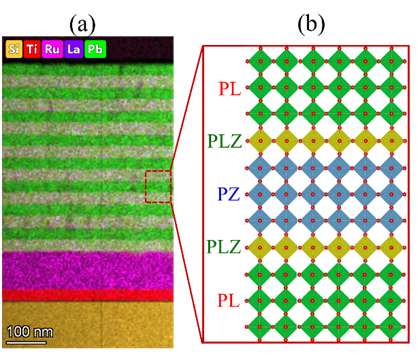The development of new electronics requires a search for materials with unprecedented properties. For example, for local electrical energy storage on a chip and very fast charge-discharge thereof, so-called miniaturized pulsed-power devices, special ferroelectric materials are being studied. Scientists of the Inorganic Materials Science group (MESA+ Institute, University of Twente) alternate thin layers of two materials, lead zirconate (PbZrO3 – PZ) and lanthanum-doped lead zirconate titanate (Pb0.9La0.1Zr0.52Ti0.48O3 – PL) and show that the favorable properties of both materials reinforce each other in a multilayer. In addition, the layering also ensures that the maximum voltage that can be applied is significantly higher. These factors result in a strongly enhanced recoverable energy-storage density (increased by a factor of 4 to 128.4 J/cm3) with high release efficiency (81.2%). Moreover, the multilayer films are very robust, even after many charging cycles. The results were recently published in the leading journal Advanced Energy Materials.

Figure 1. (a) Energy-dispersive X-ray spectroscopy of [PL/PZ]N=8 multilayer, (b) Zoom-in schematic structure at the PL/PZ interface.
Enhancing the Energy-Storage Density and Breakdown Strength in PbZrO3/Pb0.9La0.1Zr0.52Ti0.48O3-Derived Antiferroelectric/Relaxor-Ferroelectric Multilayers
Minh D. Nguyen, Yorick A. Birkhölzer, Evert P. Houwman, Gertjan Koster, Guus Rijnders
https://doi.org/10.1002/aenm.202200517





